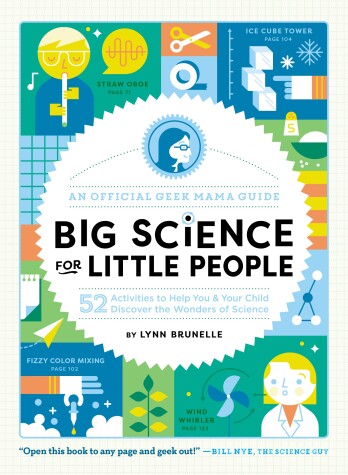
Make your child's first forays into science fun! 52 clever and easy experiments for things that will zip, zoom, and fly, and fizz, bubble, and burst. For children ages 4 to 8.
Introduce future engineers, inventors, naturalists, and artists to the physics and chemistry, biology and ecology behind everyday play. Create chemical reactions, explore gravity and friction, transform states of matter, play with air pressure, and much more through 52 simple experiments that zip and zoom, fly and fizz, bubble and burst. Geek mom Lynn Brunelle has created an interactive guide perfect for both kids and their parents: the projects will engage children, and the informative lessons will help parents when asked the inevitable question, why?
The projects include:
1. The Exploding Lunch Bag: Will you get out of the way before the vinegar and baking soda react with a fizzy burst?
2. Seed Hunt: Seek out whirly, sticky, and smooth seeds for a science-filled outdoor adventure!
3. The Marshmallow Launcher: Harness energy to fling sugary treats in the name of science.
4. And many more!
I knocked half a star off because there are some detrimental editing errors scattered throughout (i.e. errors that affect the ability to carry out the instructions). Otherwise, it's a great collection of experiments to do with kids that illustrate some fundamentals of science. A few are super-basic, like how to make a paper airplane. But a lot of them are clever, creative, and sound like a lot of fun. A bonus for me were the number of experiments that involve exploding things. (What can I say? I like exploding things. Safely.)
The author did a decent job writing up the instructions and explanations. Her introduction was a little too parent focused, if I'm being nit-picky (obviously, I am). You don't have to be a parent to find this book useful; aunts, uncles, grandparents, and teachers will all find it a fun resource too, and it wouldn't have taken much thought to write for the wider audience.
Her explanations are bare-bones basic, but they seemed to cover the broad-concept basics, and often included suggestions for how to explain the science in terms kids could easily grasp. My only other complaint that went towards the 1/2 star deduction is that while she offers suggestions for how to take the experiments further, she doesn't offer any explanation for why these supplemental variations might deviate from the original experiment. I can see how this might leave the adult at a loss for a properly scientific explanation.
Some of the experiments that will get a go here next time the nieces are around include Magic Milk, Crystal Snowflakes, Marshmallow launcher, Super-squirter water blaster, and the one I'm personally most excited about: Exploding Sidewalk Chalk. It's messy, it's colourful, and best of all, it EXPLODES! :D
Reading updates
-
Started reading
-
2 January, 2019:
Finished reading
-
2 January, 2019:
Reviewed
